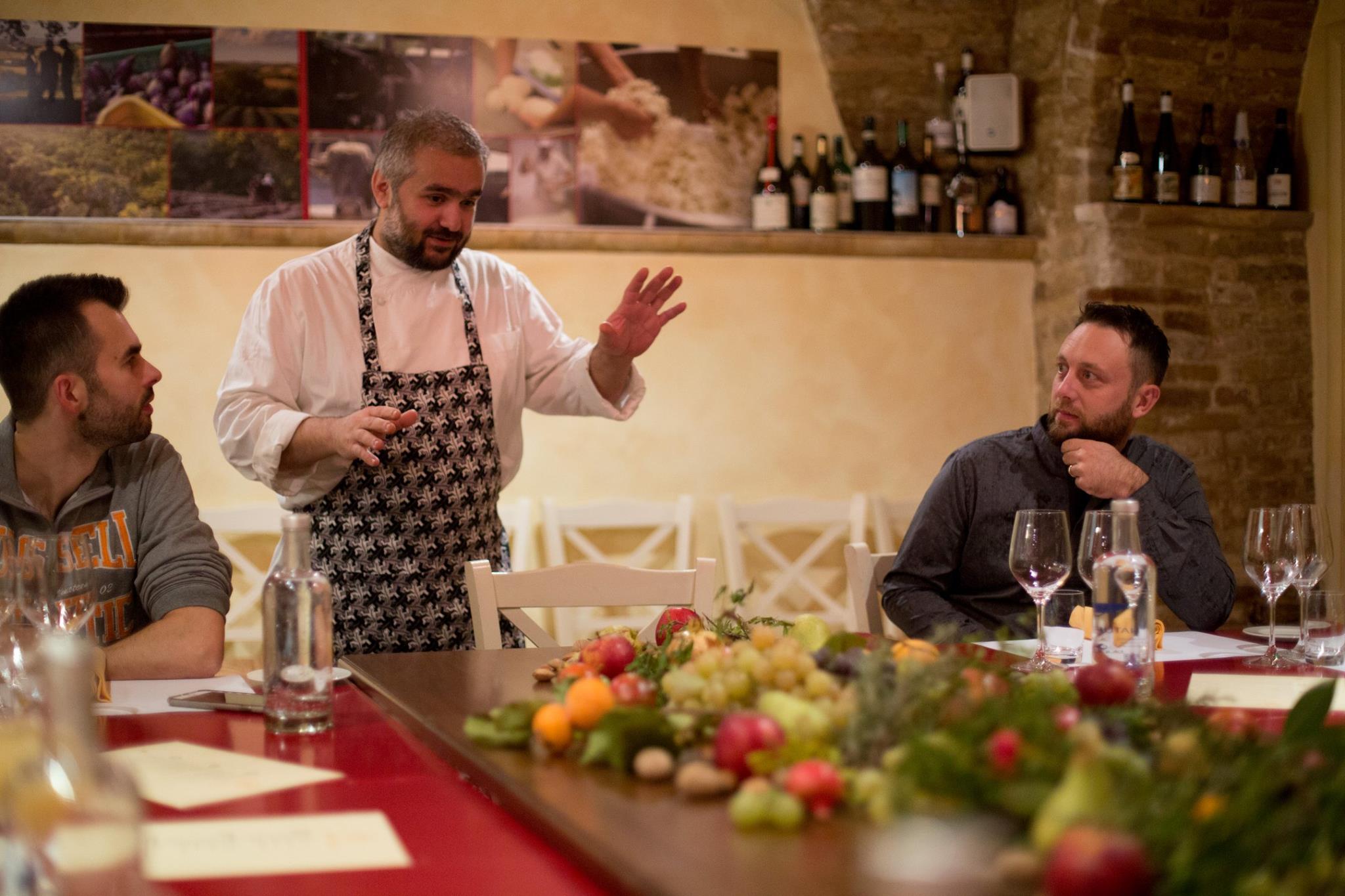{:it}
Filottrano si erge sulle lievi colline a pochi kilometri da Jesi. Noto più che altro per un’epidemica diffusione capillare di stabilimenti e outlet per l’abbigliamento maschile (una volta mi peritai di calcolare la media di un’impresa tessile ogni 6 abitanti), di grandi e piccoli brand o di comuni terzisti, fino all’invenzione – per le Marche – del su misura per uomo, magari noto agli sportivi per aver vestito prestigiose squadre e qualche vip.
Ma, come ogni paesello di questo territorio, è uno scrigno di sapori tradizionali. Non molti anni fa, nel 2014, sulle mura antiche della città, sotto un piccolo arco di fronte alla chiesa, è spuntato il Gallo Rosso. La Trattoria Gallo Rosso, come tengono a specificare i due titolari – ma forse è più giusto chiamarli “creatori” – Gessica Mastri e Andrea Tantucci.
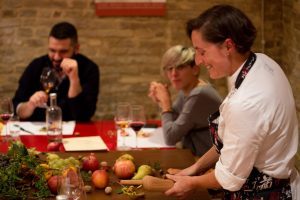
Infatti, al Gallo Rosso si sente la tradizionale connotazione che si dà al termine, ma con quel tanto di contemporaneo e rielaborazione che ne fanno un unicum nella cucina del territorio.
Alla domanda che si fa ad ogni intervistato (“In due parole, cosa vi contraddistingue?”), Andrea a Gessica, quasi in coro, rispondono: “Cuciniamo quel che ci piace mangiare a casa. I piatti che preparava la nonna, gli ingredienti e i profumi che riempivano le stanze quando si preparava il pranzo”.
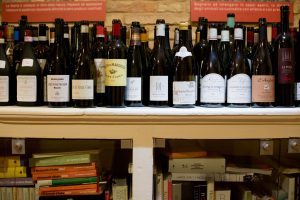
Il punto di forza (è sempre la seconda domanda, di solito) sono gli ingredienti, lo ripetono più d’una volta. “È una cucina legata ai produttori, con un rapporto diretto – spiega Andrea – e questo è un caso abbastanza unico dalle nostre parti: la trattoria che vuol aver la vita facile presenta un menu con un primo al ragù, un arrosto misto… Noi, in ogni piatto, raccontiamo la storia che c’è dietro: non ti presento solo il mio lavoro, ma anche la passione, il sudore di chi ci ha lavorato prima di me. È qualcosa di più che una semplice ricetta: il menù lo costruiamo dalla materia prima disponibile”.
E ogni due o tre frasi Andrea e Gessica tirano fuori un nome come Doriano Scibè, il caseificio Piandelmedico, il pastificio Mancini o il frantoio Valeri. Li chiamano per nome (Doriano, Giulia…), come fossero persone di famiglia: “La carne Doriano te la porta quando può, quella che c’è, secondo stagione. Magari arriva alle 4 di notte per scaricare, quando ha finito il lavoro in allevamento. L’ingrediente non ci arriva col corriere, in buste sottovuoto che puoi tagliare e buttare in padella e dopo pochi minuti è pronta. No, questi sono gli ingredienti che si trovavano una volta. Sono prodotti difficili da lavorare, ma al palato te ne accorgi subito, prima di pensare a come sono trattati, a qual è la ricetta”, raccontano con passione e divertiti Gessica e Andrea.
IN tre parole, il Gallo Rosso è: Materia prima, Tradizione e Convivialità (è l’estrema sintesi che estorco ai due). “Credo che chi viene qui – dice Andrea – abbia già uno spaccato di dove si trova, delle Marche. È uno specchio di ciò che abbiamo intorno: non un km Zero vero è proprio, ma il meglio di ciò che abbiamo intorno, che lavoriamo bene, nel rispetto degli animali. Quindi, niente prodotti da allevamenti o agricoltura intensivi”.
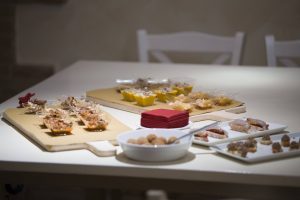
Capire che due pilastri sono materia prima e tradizione è facile, basta uno sguardo al menu. Il piatto principe qui è l’oca cotta nel Verdicchio: ne cantava le lodi Gianni Mura su Il Venerdì di Repubblica, nella sua rubrica Mangia e Bevi, consigliando “a tutti di venire a Filottrano a mangiare l’oca cotta nel Verdicchio alla Trattoria Gallo Rosso”. La trovate tutto l’anno nel menu, tranne che nei tre mesi invernali (tradizione, dicevamo, appunto); oppure i maccheroni con l’oca del batte (il sugo che si faceva nel periodo della battitura del grano… tradizione, antica, appunto); sui primi troviamo anche le tagliatelle Gallo Rosso, con un jus di carni e parmigiano; o il “piatto che non t’aspetti”, come lo definisce Andrea, il coniglio lesso servito con acciughe salate e borragine: un profluvio di profumi, prima ancora di vedere il piatto! O ancora, il patè di fegato di marchigiana (Angus?! What the f@©#!?…) con riduzione di Rosso Piceno e nocciole.
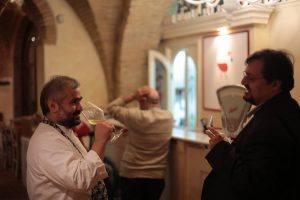
Materia prima e tradizione: a questo punto sembra facile e naturale generare convivialità. Bhè, i due ci mettono un ingrediente in più. Un calendario fittissimo di appuntamenti dedicati, spettacoli, cene/conferenza sul cibo, la storia, serate di “musica&cibo” (non è un caso: nel 2009 Andrea è l’autore, con Paola De Angelis, di Rockitchen: 30 menu per 30 dischi. Chi l’ha letto sa già qual è il mood di queste serate), eventi, letture. Un solo dogma: chi guida queste serate e parla di musica, di cibo, di vino, di poesia deve essere un professionista. Qualche nome, oltre alla già citata De Angelis? Solo per citare quelli nei programmi a venire, Tommaso Lucchetti,Romina Antonelli, Michele Alesiani… ce n’è per ogni gusto, per ogni senso.
{:}{:en}
Filottrano lies upon the gentle hills few kilometers away from Jesi. It is well known for a widespread epidemic dissemination of men’s wear factory stores and fashion outlets (once I calculated a range of a textile factory each 6 inhabitants), of unknown and famous brands or common subcontractors, up to the invention – for the region Marche – of the custom tailored suits for men, suits worn by sports’ teams and VIPs.
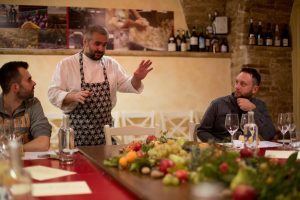
Such as many other village in our region, Filottrano is a treasure chest for traditional flavors. In 2014, not so many years ago, Gallo Rosso was established on the ancient town walls under a small arch in front of the church. Gallo Rosso is a Trattoria indeed, as its two owners – or maybe better call them “creators”, Gessica Mastri e Andrea Tantucci – want to underline.
In fact, at the Gallo Rosso you feel the traditional connotation of the word, but also added with a contemporary touch and reprocessing style that make the trattoria a unique experience compared to the local cuisine.
To the question that every interviewer does (“In a couple of words, what is your distinctive feature?”), Andrea and Gessica – almost in unison – answer: “We cook what we love eating at home. The dishes my grandpa used to cook, ingredients and smell that could fill the rooms while cooking for lunch.”

Our strong point (is usually always the second question) is the ingredients they use, they repeat that more than once. “Our cuisine is firmly connected to producers, by a direct relationship – Andrea explains – and this a unique situation in our area: much easier would be a trattoria where you can eat Pasta al Ragù as first course, and roast meat to follow… We tell the story of each dish we offer, instead: I don’t want to present only my work, but also the passion and sweat of everyone who has worked to produce the food. It is something more than only a simple recipe: our menu comes from the available raw materials”.
Every two or three sentences Andrea and Gessica tell me about Doriano Scibè, the cheese factory Piandelmedico, the pasta factory Mancini or olive oil factory Valeri. They call the suppliers by first name (Doriano, Giulia…), as if they were one of the family: “Doriano supplies meat whenever he can, what is fresh and available at the moment, in accordance to the season. It might happen that he delivers at 4 a.m. in the morning, after he finished his job at the farm. Ingredients are not delivered by couriers in vacuum-sealed bags that you can open and cook in few minutes. The ingredients we use, are the ones you used to be cooked in the past. They are products difficult to cook, but you can actually taste the difference, right before you can think of how they were treated and which is the recipe we use”, Andrea and Gessica tell me with passion and amusement.

In three words, Gallo Rosso is: Raw material, Tradition and Conviviality (this is the extreme summary I wrang out of them). “I believe that our customers – says Andrea – already knows our region, Marche. It is just a mirror of what surrounds us: it is not a pure farm-to-table, but it is just the best we have around us, that we cook in the best way, respecting animals. So that we don’t use at all products from industrial breeding farms or intensive agriculture”.
It’s easy to understand that raw material and tradition are two main features, just taking a look at the menu. The main dish is goose cooked with Verdicchio wine: Gianni Muro on Il Venerdi di Repubblica also praise the dish, in his section Mangia e Bevi advising that “everyone should go to Filottrano and eat Goose cooked with Verdicchio wine at the Trattoria Gallo Rosso”. The dish is all year long on the menu, except during the three winter months (tradition, we said); or Macaroni with Goose “del batte” (the typical sauce used for pasta during the threshing…ancient tradition, as well); among the first courses there are also Tagliatelle Gallo Rosso style, with a “jus” (meat juices) of meats and parmesan cheese; or the “dish you do not expect”, as Andrea defines it, the boiled rabbit served with salted anchovies and borage: a smell profusion, even before you eat it! And still, fois gras pâté of Marchigiana meat (Angus?! What the f@©#!?…) with a reduction of Rosso Piceno red wine and hazelnuts.
Raw material and tradition: to this point it seems easy and natural to create conviality. Well, those two add in another ingredient. A thick agenda of selected events, shows, gala dinners / conferences about food and food history, “music&food” evenings (it’s not a case: in 2009 Andrea is author, together with Paola De Angelis, of Rockitchen: 30 menues for 30 LPs. Those who read it, already knows the mood of those events), readings and events. Only one dogma: who manages these events and speaks about music, food, poetry must be definitely an expert. To name a few, together with the said Mrs. De Angelis? Let’s name those who will join the shows in the future, Tommaso Lucchetti, Romina Antonelli, Michele Alesiani… for everybody’s taste, for every sense.

Such as many other village in our region, Filottrano is a treasure chest for traditional flavors. In 2014, not so many years ago, Gallo Rosso was established on the ancient town walls under a small arch in front of the church. Gallo Rosso is a Trattoria indeed, as its two owners – or maybe better call them “creators”, Gessica Mastri e Andrea Tantucci – want to underline.
In fact, at the Gallo Rosso you feel the traditional connotation of the word, but also added with a contemporary touch and reprocessing style that make the trattoria a unique experience compared to the local cuisine.
To the question that every interviewer does (“In a couple of words, what is your distinctive feature?”), Andrea and Gessica – almost in unison – answer: “We cook what we love eating at home. The dishes my grandpa used to cook, ingredients and smell that could fill the rooms while cooking for lunch.”
Our strong point (is usually always the second question) is the ingredients they use, they repeat that more than once. “Our cuisine is firmly connected to producers, by a direct relationship – Andrea explains – and this a unique situation in our area: much easier would be a trattoria where you can eat Pasta al Ragù as first course, and roast meat to follow… We tell the story of each dish we offer, instead: I don’t want to present only my work, but also the passion and sweat of everyone who has worked to produce the food. It is something more than only a simple recipe: our menu comes from the available raw materials”.
Every two or three sentences Andrea and Gessica tell me about Doriano Scibè, the cheese factory Piandelmedico, the pasta factory Mancini or olive oil factory Valeri. They call the suppliers by first name (Doriano, Giulia…), as if they were one of the family: “Doriano supplies meat whenever he can, what is fresh and available at the moment, in accordance to the season. It might happen that he delivers at 4 a.m. in the morning, after he finished his job at the farm. Ingredients are not delivered by couriers in vacuum-sealed bags that you can open and cook in few minutes. The ingredients we use, are the ones you used to be cooked in the past. They are products difficult to cook, but you can actually taste the difference, right before you can think of how they were treated and which is the recipe we use”, Andrea and Gessica tell me with passion and amusement.
In three words, Gallo Rosso is: Raw material, Tradition and Conviviality (this is the extreme summary I wrang out of them). “I believe that our customers – says Andrea – already knows our region, Marche. It is just a mirror of what surrounds us: it is not a pure farm-to-table, but it is just the best we have around us, that we cook in the best way, respecting animals. So that we don’t use at all products from industrial breeding farms or intensive agriculture”.
It’s easy to understand that raw material and tradition are two main features, just taking a look at the menu. The main dish is goose cooked with Verdicchio wine: Gianni Muro on Il Venerdi di Repubblica also praise the dish, in his section Mangia e Bevi advising that “everyone should go to Filottrano and eat Goose cooked with Verdicchio wine at the Trattoria Gallo Rosso”. The dish is all year long on the menu, except during the three winter months (tradition, we said); or Macaroni with Goose “del batte” (the typical sauce used for pasta during the threshing…ancient tradition, as well); among the first courses there are also Tagliatelle Gallo Rosso style, with a “jus” (meat juices) of meats and parmesan cheese; or the “dish you do not expect”, as Andrea defines it, the boiled rabbit served with salted anchovies and borage: a smell profusion, even before you eat it! And still, fois gras pâté of Marchigiana meat (Angus?! What the f@©#!?…) with a reduction of Rosso Piceno red wine and hazelnuts.
Raw material and tradition: to this point it seems easy and natural to create conviality. Well, those two add in another ingredient. A thick agenda of selected events, shows, gala dinners / conferences about food and food history, “music&food” evenings (it’s not a case: in 2009 Andrea is author, together with Paola De Angelis, of Rockitchen: 30 menues for 30 LPs. Those who read it, already knows the mood of those events), readings and events. Only one dogma: who manages these events and speaks about music, food, poetry must be definitely an expert. To name a few, together with the said Mrs. De Angelis? Let’s name those who will join the shows in the future, Tommaso Lucchetti, Romina Antonelli, Michele Alesiani… for everybody’s taste, for every sense.
{:}

